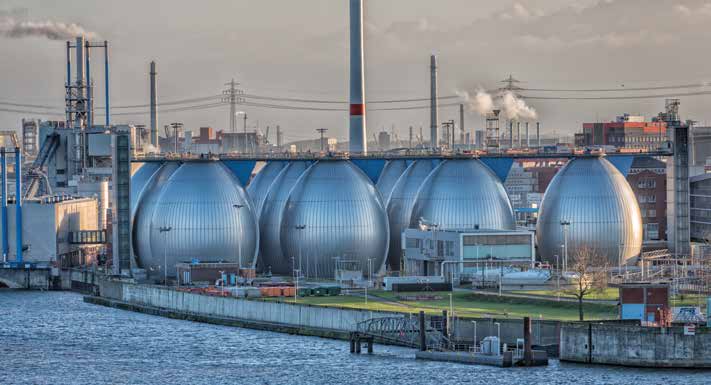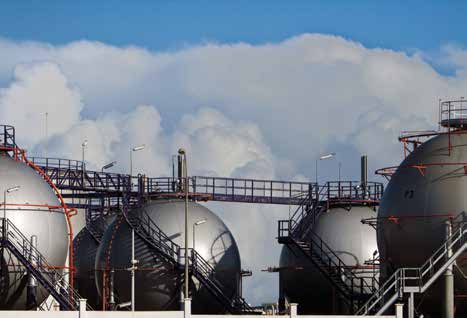OFFER HOPE FOR WATER CRISIS

The massive stainless steel desalination plant in Hamburg’s port offers a solution to water shortages
Day zero is looming for Cape Town and a dedicated and efficient long-term solution to South Africa’s water woes must be found. The weather can’t be controlled and drought patterns for the region are set to worsen. It’s time to stop relying solely on rainfall and dam levels for clean water as a critical resource.
South Africa boasts a coastline of over 2 500 kilometres so it should be considering the oceans as an abundant water supply.
Converting seawater to clean drinking water can be achieved by desalination, a proven technology that’s been used around the world. Desalination involves removing the salinity (dissolved salts and minerals) from water. There are a number of ways of doing this, but the only process that ticks all the boxes in terms of catering for large volumes, environmental impact and cost, is reverse osmosis.
South Africa has around 10 desalination plants dotted along the coast from Lambert’s Bay in the west to Richards Bay in the east. The output from each is quite small and caters only for households in the immediate vicinity.
Cape Town has started down the road of desalination. A temporary desalination plant is due to start producing 2 000 cubic metres of water a day (going up to 7 000 in phase 2) starting in March. The city will buy the water at a cost of around R30 per kilolitre. The contract is due to run for two
years after which the equipment will be removed and the area rehabilitated.
But the city needs to develop far more ambitious plans. With a population of about 4 million people it needs a water output of about 500 000 cubic metres per day to supply each individual with roughly 100 litres. Desalination plants have dramatically increased in number and sophistication
around the world due to membrane technology breakthroughs and energy saving equipment.
SUCCESSFUL DESALINATION
Successful desalination requires a material that can resist the aggressive corrosion caused by seawater and brine. Utilising stainless steel to create fresh water further increases the sustainability profile of the desalination industry. The durability and minimal maintenance requirements of stainless make it a good choice economically. The high level of recycled content and 100% recyclability at the end of its life are the cornerstones of stainless steel’s environmental profile. High performance stainless steels such as duplex grades, are the perfect choice for desalination.
WHY STAINLESS STEEL
Thermal and membrane technologies are the two main methods used to desalinate water. Thermal methods of desalination include Multi Stage Flash Distillation (MSF) and Multi Effect Distillation (MED), while membrane technologies include Reverse Osmosis (RO) and lectrodialysis/Electro dialysis Reversal (ED/EDR). Stainless is used in all of these technologies, primarily because of its corrosion resistance properties.
All desalination processes work in the same way. The incoming salt water is separated into two parts: treated and concentrate. The treated water has a very low level of salt while the concentrate has a higher level of salt than the raw sea water. An absolute necessity for the process to work is the use of corrosion resistant materials in the construction of the plant. Material selection and design criteria are affected by the specific operating conditions the material will be exposed to during its lifetime. Many of these criteria are perfectly met by stainless steel. Stainless should be utilised wherever corrosion resistance and durability are key requirements.
WHICH STAINLESS STEEL
Although there are over two hundred stainless steel grades on the market, only a handful are utilised in desalination applications. The primary property required from any material used in desalination is corrosion resistance in a wide variety of aqueous environments.
Austenitic stainless steel in the 300 series (316L and 317L) are the predominant materials used to make the components of a desalination plant. Type 316L is useful in environments with a marine atmosphere.
However, if it is immersed in seawater it can suffer pitting and crevice corrosion.
The tendency to pit in chloride containing environments may rule out the use of stainless in distillation plants which handle hot, concentrated seawater.
Although hot seawater lacks oxygen, which reduces the tendency of stainless to pit, most modern MSF plants do not use grade 316L. Historically, 316L has been the material of choice for the evaporators. However, most desalination technology providers have now switched to using duplex alternatives for this application.

Dual duplex systems are used in many desalination plants, with grade 2205 used in hostile environments and lean duplex used in the less corrosive applications
Duplex stainless steel exhibits good resistance to corrosion, especially to stress corrosion cracking (SCC). SCC is the unexpected sudden failure of normally ductile metals that have been subjected to a tensile stress in a specific corrosive environment, especially at elevated temperature. Duplex stainless grades have twice the strength of austenitic grades and are particularly cost effective because of their mechanical properties. They are also
excellent engineering materials. Duplex grade 2205 has already been utilised in MSF evaporator shells, both in the Melittah plant in Libya and the Skikda plant in Algeria (constructed in 2004 and 2005).
Duplex grades were also specified for large plants engineered by FISIA, an Italian company that specialises in building desalination plants. Built examples include the Taweelah B extension in Abu Dhabi, the Jebel Ali l plant in Dubai and the Ras Abu Fontas desalination plant in Qatar. These
projects utilise the “dual duplex” concept where grade 2205 is used in the more hostile environments in the plant, while lean duplex is used in less corrosive applications.
Lean duplex is a cost effective duplex stainless steel that has lower nickel and molybdenum contents than 2205. Corrosion resistance is very close to that of grade 316L.
The high strength of lean duplex makes it possible to reduce the gauge by up to 50% compared with austenitic 300 series grades. However, restrictions in design codes limit the real savings to about 35% to 40%.
Experience from 27 seawater reverse osmosis (SWRO) plants already in service confirm that there is a risk of corrosion if the wrong stainless grade is used in the high pressure piping. Neither grade 316L or 317L possess sufficient corrosion resistance.
Not even highly alloyed grades (such as 2205 and 904L) show reliable service performance in this application. However, no corrosion has been reported for new super austenitic stainless grades, which have been used in more than 30 full strength SWRO plants and several plants using brackish water with high salinity.
CONCLUSION
In the long-term, new and more sustainable methods for water production by desalination and energy recovery must be found. Squeezing fresh water from the ocean might be the only viable way to increase the supply and there is now enough evidence to show that large seawater desalination plants are practical.

